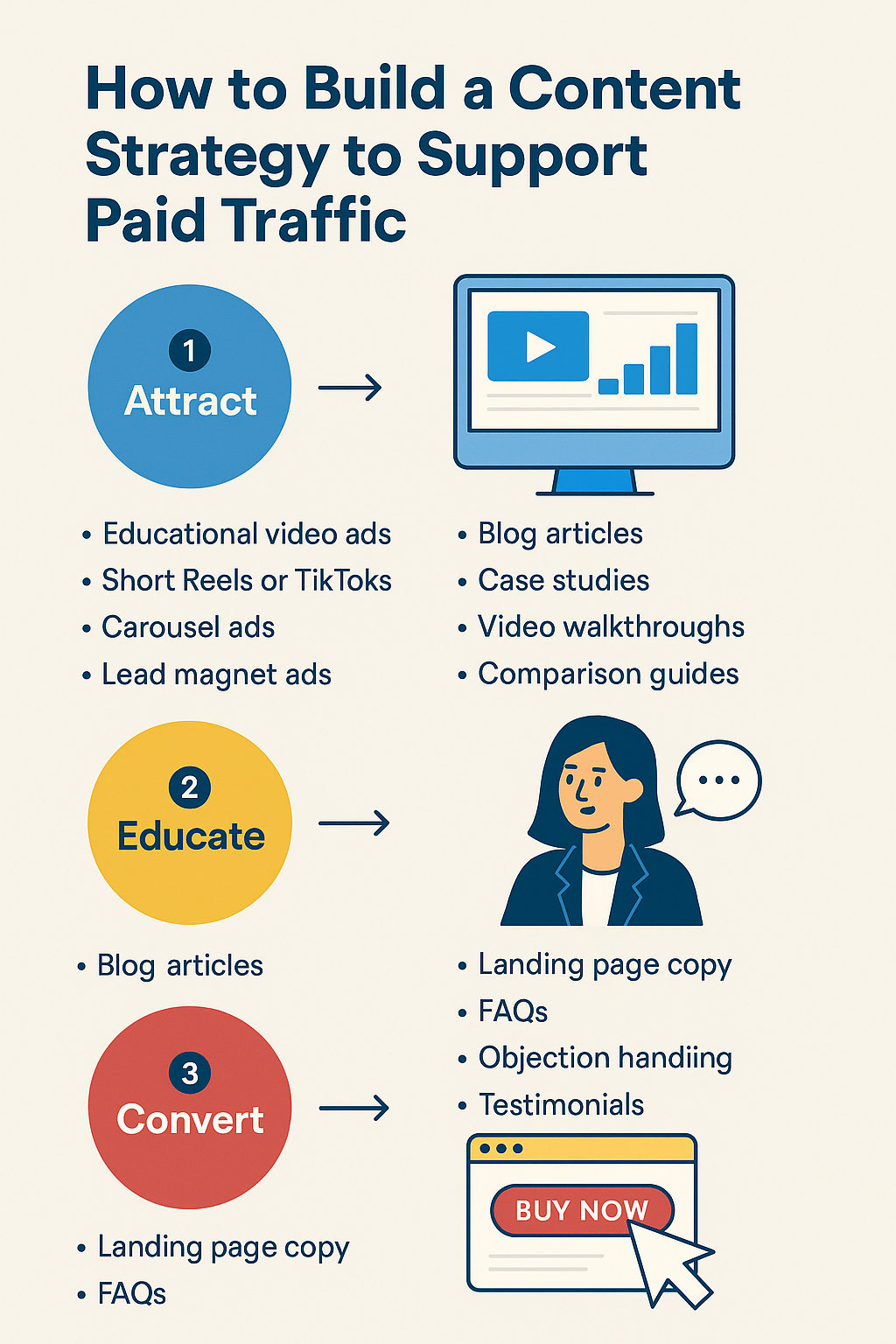Paid traffic can bring people to your brand — but what happens after the click often determines whether they convert.
That’s where your content strategy comes in.
When done right, content helps you:
- Warm up cold audiences
- Build trust
- Educate leads
- Increase conversion rates
- Reduce ad costs over time
In this article, you’ll learn how to create a content strategy that works with your paid traffic campaigns — not separately from them.
Why Paid Traffic Needs Content
Many people think content is for organic marketing only. But in fact, content and ads work better together.
Here’s how content supports paid traffic:
✅ Makes your offer more trustworthy
✅ Gives value before asking for commitment
✅ Feeds your retargeting audiences
✅ Helps position you as an expert
✅ Answers objections before the sales pitch
The result? Lower cost per lead, higher conversion rates, and better long-term ROI.
What “Content Strategy” Really Means (For Ads)
You don’t need to become a full-time blogger or influencer.
Instead, your paid traffic content strategy should focus on 3 goals:
- Attract – Get attention from cold audiences
- Educate – Warm up and nurture leads
- Convert – Guide the lead toward a decision
Let’s break that down with examples.
Step 1: Attract Cold Traffic With Content-Based Ads
Instead of going straight for the sale, create content-style ads:
- Educational video ads (1–2 minutes)
- Short Reels or TikToks with tips
- Carousel ads showing a process
- Lead magnet ads offering free resources
🧠 Example:
“3 mistakes new freelancers make with pricing — and how to fix them”
(Use as a video ad, blog post, or email lead magnet)
Step 2: Retarget With Value-Adding Content
Once someone engages, you can retarget them with:
- Blog articles that answer key questions
- Case studies or testimonials
- Video walkthroughs or behind-the-scenes
- Comparison guides (you vs. competitors)
- User-generated content (UGC)
Content here does the job of building trust and pre-selling.
Step 3: Support Your Funnel With Evergreen Content
On your website or landing pages, publish content that:
- Supports your paid offer
- Builds credibility
- Helps SEO in the long term
- Answers objections your leads may have
Examples:
- FAQ sections
- “How it works” videos
- Educational blog posts linked to your lead magnets
- Testimonials or success story articles
What Type of Content Works Best With Paid Ads?
| Content Format | Best Use |
|---|---|
| Blog Posts | Retargeting, nurture email sequences |
| Video (1–3 mins) | Cold audience ads, retargeting, Reels |
| Carousels | Instagram/Facebook ads and education |
| Lead Magnets | List building + first point of conversion |
| Landing Page Copy | Sales support and objection handling |
| Case Studies | Social proof + authority |
You don’t need to produce daily content — focus on quality pieces that align with your ad funnel.
How to Organize Your Paid Traffic Content Funnel
🔵 TOFU (Top of Funnel) – Cold Traffic
Goal: Attract and educate
- Blog post summary ads
- Quick tips video
- Lead magnet offers
- Reels or TikToks
🟡 MOFU (Middle of Funnel) – Warm Leads
Goal: Build trust
- Client success stories
- Mini-webinars
- Email sequences with tips + proof
- Video testimonials
🔴 BOFU (Bottom of Funnel) – Ready to Convert
Goal: Close the sale
- FAQs
- Comparisons (“Why us vs. X?”)
- Bonus offer reminders
- Urgency-based ads
Tools to Plan and Distribute Content
- Notion / Trello – Content calendar
- Google Docs – Copywriting and collaboration
- Canva – Design visuals and carousels
- Loom / CapCut – Create short-form videos
- Mailerlite / ConvertKit – Email sequences
- Meta Ads Manager – Promote content directly
💡 Tip: Repurpose one blog into a video, carousel, lead magnet, and retargeting ad.
Final Thoughts: Content Multiplies the Power of Ads
When you combine high-quality content with strategic paid traffic, your brand becomes:
- More trustworthy
- More memorable
- More effective at converting
You don’t need to go viral. You just need to publish the right content at the right stage of the funnel.
Let your content do the heavy lifting — and let your ads deliver it.
